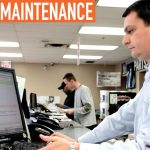What are the key elements of a solid Fatigue Management Program (FMP)? I believe it starts with commitment from the top. What’s important to your leadership will be important to your entire organization. It’s not what they say, but what they do. If your safety director is the only one talking about and being held responsible for the organizations fatigue management, then you won’t see lasting change from your FMP.
On the other hand, if your president demonstrates her commitment by sending out onboard computer messages, writing a letter to the organization committing to making safety a value, hosting training sessions on fatigue, customizing posters, etc., then the organization will respond in kind with their commitment.
KEYS TO A SAFE START
Education and training is the next key facet to an effective FMP. Here’s where NAFMP’s (www.nafmp.com) website comes in real handy. You’ll find training modules online. This education and training isn’t just geared for drivers, but also for management, spouses, and leadership. Everyone should get involved in order for the FMP to be successful. In my experience, the most effective, long-lasting initiatives were made possible because we chose to involve the employees and their families.
NAFMP goes on to describe the benefits of a comprehensive sleep disorder treatment and monitoring program, which doesn’t just screen for sleep apnea, mail out a machine, and wash your hands of the process. A comprehensive program is designed to actively care for each employee’s health from the very beginning.
For readers who are full-time safety professionals, you have probably experienced situations where your commercial drivers were referred by the DOT doctor for a sleep test and then spent weeks trying to get in for a sleep test; get consults necessary for diagnosis and CPAP set up; and get clearance to return to work. You were then left to wonder if your driver was actually using the machine consistently every day or not.
On my watch, a comprehensive sleep program consisted of a path for any driver to be tested, treated, and returned to work in just a few days under expert and consistent care—confirmed daily through technology (verifiable compliance). This reduces time and aggravation and increases the likelihood that those drivers with a sleep disorder are getting the care they need without negatively impacting their earnings or wasting their time.

Another key area to an effective FMP is taking a look at your work and scheduling tools. For example, what is your dispatch philosophy? Back in the day, when I was a new dispatcher, our philosophy was to fill my drivers’ available work hours with load assignments. My goal was to stay current with all customer commitments. Just employing this simple formula to get results is not enough. You must also consider how you get your results. Actively caring comes into play again.
Take a look at how you hire, on board, educate, and assign work tasks to your employees. Smart hiring is setting clear expectations for the job and ensuring that your employee is set up for success. Find out how far they live from work and jointly agree on a plan for how they will manage rest prior to reporting in. It may involve you setting up a sleeping arrangement for them, reducing the workload for the first day back, etc. in order to ensure that your employees are set up for success.
Your front-line leadership and support teams should actively look for signs of fatigue and be empowered to make decisions that are in the best interest of the health and wellbeing of the employee and the company. Firing someone for showing signs of fatigue only moves that problem down the road to another company. Make a commitment to treating, training, and retaining your employees instead.
YOUR GREATEST ASSET
Take some time to review the www.nafmp.com website and discuss it with your leadership. Remember, it takes work to run a successful company. People are your greatest asset. If you treat them like family and invest in their future, you can sleep safe knowing that your own future and the future of your company will be a bright one.
ABOUT THE AUTHOR:
US Army veteran and senior vice president, Business Development/New Ventures at SleepSafe Drivers®, Steven Garrish, has more than 20 years of experience in logistics and transportation serving 14 years at JB Hunt Transport Company, Inc., in Human Resources Operations and Safety. Joining Walmart in 2010, Steven worked as senior director, Private Fleet Safety, leading safety efforts for Walmart’s private fleet of more than 7,500 professional truck drivers nationwide.
_______________________________________________________________________
MODERN WORKTRUCK SOLUTIONS: FEBRUARY 2016 ISSUE
Did you enjoy this article?
Subscribe to the FREE Digital Edition of Modern WorkTruck Solutions magazine.
![]()




